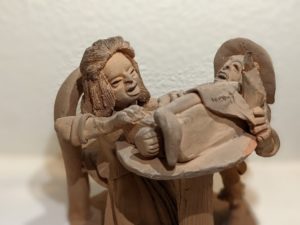Column Title: Bearing Witness: Reflections on a Life in Mission
Column Entry: A Common Hope
Column Description: If you hang around long enough, mingle with enough folks in enough places on this fragile planet, and pay attention at least part of the time, life happens. And with life, stories. In this monthly column, Dennis Smith, former President of the World Association for Christian Communication, shares communication insights and wisdom gleaned from 43 years of service as a Presbyterian mission worker in Latin America. Through mission service, God gifted Dennis with quite an assortment of relationships. Through them, the Divine whupped him upside the head and “invited” him to pay attention. To be present. To bear witness.
November 2021 / October 2021 / September 2021
A Common Hope
In 2016 I was invited to participate in a workshop for parish communicators of the Waldensian Church in Argentina. To begin my talk, I sat a small clay sculpture on a table in the middle of our circle. It presents a young woman sitting at a table pounding on a manual typewriter. A barefoot peasant clings to her arm with his right hand and grasps a rolled-up sheet of paper in his left. The sculpture has the grotesque facial features typical of art from Ayacucho in Peru’s southern Andes.
(Sculpture Artist Unknown, from the Ayacucho region of Peru. Photo Courtesy of Nadia Serruya)
The small piece pulses with intensity and illustrates a now almost defunct craft long practiced on market days throughout Latin America—that is, the scribe or, in Peruvian slang, the escribidor. The illiterate majority paid a small fee to the local escribidor to act as their go-between with the literate world, entrusting the scribe with tasks ranging from filling out government forms to composing love letters.
As the participants shared what they saw in this small sculpture, I noted that as communicators words are the raw material we use to create meaning in common with others. We use words to tell stories, and the stories we tell can describe how and where God is present in our world. Our lives are seldom straightforward, so we learn to use words to convey both specificity and ambiguity, immanence and transcendence. We learn not to fear contradiction in our writing and to balance precision with nuance. In a world where words are employed as mercenaries to hype consumer goods and partisan causes, we remember that words can also promote truth and justice. Words can be bearers of grace.
Yet even my generation, the children of Guttenberg, has learned the limits of words. Yes, words can be bearers of mystery and beauty, longing and loss, but they often fail to suggest the ineffable, the unspeakable. Image and gesture, sound and silence, taste and smell can all create meaning beyond the power of words.
Around the circle of parish communicators, we all agreed that words are not enough to meet today’s communication challenges. This is especially true for evangelical Protestants in traditionally Roman Catholic regions like Latin America. A quick history lesson may help us understand why.
Protestant mission efforts in Latin America date back to the first half of the nineteenth century, coinciding, it turns out, with the political and military movements that led to the creation of the region’s nation states. As Latin America moved beyond the colonial era, Protestants demonstrated a decidedly modern approach to religious practice while Roman Catholicism positioned itself as the defender of conservative religious tradition and declining European empires.
Throughout the colonial era, Catholicism, the religion of both Portuguese and Spanish royalty, had great cultural and economic power. During colonial times, the Catholic Church had been charged by these empires with cultivating religious identity, sustaining the political and economic status quo, and defining the differences between colonizer and colonized.
As the colonial era came to an end and nation states were formed, the emerging Latin American political and economic elites were deeply influenced by European Liberalism—they promoted less-regulated markets, representative democracy and the separation of Church and State. They were also influenced by the Positivism of Auguste Comte and John Stuart Mill, believing that education, science and technology offered the key to a promising future. In some cases, the new Protestant missions became their de facto allies. Many US missionaries built schools and hospitals and came to be celebrated for their practicality and entrepreneurial spirit, offering Liberal reformers living examples of their revolutionary aspirations.
The Protestant missionary impulse was also rooted in their understanding of themselves as the children of the Enlightenment and in their disdain for the Catholicism practiced in Latin America. Not only did they see Catholicism as being locked in medieval obscurantism, they also felt it had strayed far from Christian orthodoxy by failing to hold the line against the syncretic influences of African and Indigenous spiritualties.
Battle for the Soul of Latin America
At the level of popular religious imagination, Catholicism and Protestantism approached worship and personal piety very differently. Catholic worship, all in Latin, incomprehensible to the masses, focused on the mystery of the Eucharist.
Daily religious practice included devotion to the saints and embracing the ancient daily rhythms of a largely rural culture marked by the liturgy of the hours. The parish church or cathedral were multisensory emporia filled with didactic images, tastes and smells. The Bible was a sacred object off limits to everyone but clergy. Furthermore, the liturgical calendar divided the year into a regular cycle of religious festivals, including patron saint days for each community. All this provided a cultural architecture easily assimilated by rural Indigenous and African communities deeply imprinted by the cycles of planting and harvest, birth and death, loss and renewal.
On the other hand, Protestantism was attractive to merchants, teachers, and trades people—the natural allies of Liberalism in Latin America’s small towns and cities. Worship was centered not around the Eucharist, but the sermon—words crafted as a reasoned discourse to explain other words, a biblical text. Many Protestant churches tended to be austere spaces, eschewing liturgical vestments, the liturgical calendar and even candles because they were considered too Catholic. Many Protestant communities celebrated the Eucharist only quarterly, or even annually. Daily religious practice included personal and family prayer in the vernacular tongue, devotional Bible reading and bearing testimony to one’s faith before the community.
Despite Protestantism’s privileged position in Latin America’s new political universe, their numbers were few and Roman Catholicism continued to be the religion of the masses. In twentieth-century Latin America, Liberalism’s promise of progress gave way to the reality of conflict and profound social polarization. In time, the failures of Liberalism—and of government in general—gave birth to deep popular distrust in public institutions. In a harsh economic environment marked by mass migration to the cities, many new urban residents embarked on a search for consolation, a sense of belonging and transcendence.
The rapid concentration of masses of people in emerging urban centers created a level of social dislocation that made changing religions a viable option for many new urban dwellers, an alternative that would have been much less attractive in their traditional rural settings. In many cases, small Pentecostal churches offered desperately needed social networks to people who, by moving to the city, felt cut loose from the family structures and traditional social mores characteristic of rural communities.
Another reason for the surge in evangelicals has been the dramatic growth of Latin America’s communication infrastructure. Until the second half of the twentieth century, for example, most of Brazil’s vast territory was only sparsely populated; even today most of the population lives within 300 km of the Atlantic Ocean. By the 1970s roads, telephone lines and electric cables began to crisscross the national territory. Television networks began to build a common national identity out of a patchwork of regional cultures.
Emerging charismatic religious groups began to explore new ways of living out religious faith in Latin American culture. Faith healers adept at offering the hope of health and prosperity began to draw large crowds in marginal areas of major cities, areas marked by violence, limited social services and high unemployment. While evangelical radio programs and religious films had been contributing to the consolidation of an identifiable evangelical sub-culture since the 1930s, Latin American TV preachers in the 1980s began to change the public image of evangelicals by developing a sophisticated and politically influential network of media outlets. They produced quality programming rooted in popular music, charismatic preaching and dramatic testimonies. Evangelical music came into its own as a multi-million-dollar enterprise. By the end of the 20th Century, new information technologies such as the Internet and Web-based social media accelerated this process. Using this powerful toolkit, religious entrepreneurs—both Roman Catholic and evangelical—were able to tailor their messages to broadly diverse target audiences ranging from the urban poor to middle class youth and young urban professionals.
Historically, traditional church leaders had the power to silence or marginalize charismatic Christian groups and other religious minorities. Megachurch pastors and other new religious actors on the Latin American stage now compete with traditional church leaders, both evangelical and Roman Catholic, for cultural and political power.
Words Are Not Enough
Public expressions of religiosity and spirituality have grown rapidly in recent decades. At the same time, Latin America has witnessed the consolidation of a market economy and consumer society, driven by the rapid growth of the mass media. Both traditional and emerging media have become powerful tools for promoting not only consumer culture, but also political ideologies and religious belief systems. These are the markers of a new wave of globalization.
Words, then, are but one resource in the toolbox of that group of parish communicators as they ply their craft. In this hyper-partisan world dominated by shrill voices and startling images, their task is to build and strengthen connections between the faithful and with the larger community: stories and images of a community gathered, a candle’s flame, a shared embrace. Wine and bread, silence and song, reflections on the Word – all lead us inward, all lead us outward, calling us to faithfulness, embodying grace, imbuing in us a common hope.


